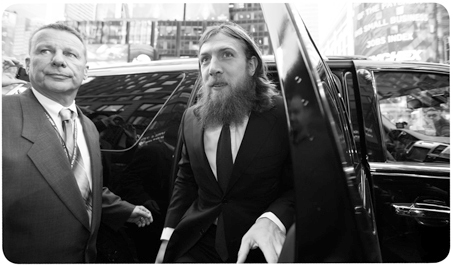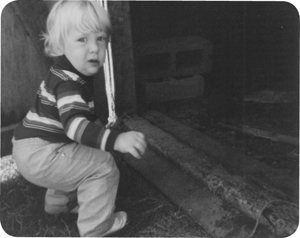
TUESDAY, APRIL 1, 2014—10:06 A.M.
This is a sight no one was supposed to see. Be it by fortune or the bureaucratic design of WWE brass, all signs suggested WWE Superstar Daniel Bryan would surface at WrestleMania 30 in a memorably competitive match yet in a far less marquee position than the main event bout for the WWE World Heavyweight Championship. He’d have been a contender for show-stealer but not positioned to make history, just a midshow blip on the radar of fans around the world during the thirtieth edition of WWE’s grandest event.
Instead, Bryan is emerging from a private car parked at the mouth of New York City’s Hard Rock Cafe. He’s about to make a grand entrance into not just this morning’s press event but what will be the most significant week in his career.
That signature beard is unmistakable, though the crisp suit he’s wearing—a rarity—feels only slightly “Bryanized” by the shade of his shimmering maroon tie. Cameras flash, and members of the press squeeze in tight to capture a modest, five-foot-eight former vegan who quite quickly stirs a supportive reaction from a notoriously opinionated Big Apple crowd.
“Yes! Yes! Yes!” A simple, direct, and infectious string of words serves as entrance music for Bryan as he crosses the red carpet and pauses beneath a telltale marquee beaming WRESTLEMANIA 30 in its LED glow. The synchronized “Yes!” chants drown out the late-morning Manhattan traffic in Times Square, and Bryan joins the throng for a brief, impromptu rally of sorts.
At this moment, Bryan stands a mere dozen blocks from the site of the inaugural WrestleMania, which emanated from world-famous Madison Square Garden almost three decades ago. Then, Vince McMahon’s first major event was the symbolic underdog looking to sink its teeth into pop culture and create a worldwide phenomenon. It’s fitting that Daniel Bryan’s own fifteen-year journey to the main event of the “Show of Shows,” WrestleMania, makes this all-important stop in the heart of New York City.
Bryan’s forged his share of memories in this metropolis, yet this day is different. This is the beginning of a week even he perhaps never believed he’d live. On his Road to WrestleMania, this moment marks the final steps toward his ultimate destination: the WWE World Heavyweight Championship match at the biggest WrestleMania ever.
There’s the ring within which he’ll compete, and then there are the lingering visions of the ring he’ll slide onto his fiancée’s finger in eleven days. Bryan’s experiencing the most significant moment in his professional career, but in his personal life, he’s in the middle of wedding-day preparations with WWE Diva Brie Bella. A beloved couple in the eyes of adoring fans around the globe, “Braniel” is still negotiating table assignments for their nuptial celebration while readying themselves to compete at WWE’s Show of Shows. There can be no more meaningful month—week, really—than this if you’re Aberdeen, Washington’s bearded son.
In Bryan’s case, in mere days, thirty years of WrestleMania culminate simultaneously with a squared-circle Manifest Destiny, a “Yes!” Movement. On that day, a fairy tale unfolds for Daniel Bryan, and the so-called Face of WWE stands to become a bit more bewhiskered.
WWE recently asked many of their successful Superstars to take a personality inventory. In theory, these tests are able to assess personal qualities, such as sociability, prudence, and interpersonal sensitivity. The idea is that different professions require different personal characteristics, but these sorts of analytics had never been done with professional wrestlers. If WWE could find out the personality traits of their most successful Superstars, perhaps when they were recruiting, it would give them more information about the likelihood of a new signee being successful. I was one of the many people chosen to take the test.
The test involved reading many different statements and then indicating if the statement was true or false. For example, one statement would be: “I would want to be a professional race car driver.” My answer: “False. I would not want to be a professional race car driver.” Another example: “I rarely lose my temper.” My answer: “True.” Stuff like that. You respond to hundreds of those types of statements and voilà! Therein are your personality traits. In theory.
I actually enjoyed taking the test and was interested to hear the results. The next day I met with a woman to talk about them. Everything was done on a percentile basis, and as we went over the results, she became more and more baffled. In all the primary markers except one (learning approach, for which I was in the eighty-fourth percentile), I scored low. And I mean very low. For interpersonal sensitivity, I was in the bottom eleventh percentile. For the adjustment category, the bottom ninth percentile. Sociability, bottom third. But the one that really puzzled her was my score for ambition, which was the lowest she had ever seen in her history of administering this kind of testing and data. I was in the bottom one percentile.
She asked me how I had managed to be so successful given that I seem to have no drive, few social skills, and an inherent apathy toward most of the ideas our modern business culture seems to find so important.
“I have no idea,” I said. “I just love to wrestle. The success has come mostly by luck.”
My “lack of ambition” must have been a part of my personality even from my inception, because I stayed in the womb for over ten months. When my wife, Bri,1 heard the story, she said it explained me perfectly. She could just imagine me being completely satisfied sitting there with an umbilical cord for a feeding tube, being constantly fed and warm and never wanting to come out. When they finally induced my mother, one can imagine how painful it must have been. My mom, Betty, was a small woman, and when I, Bryan Lloyd Danielson, finally decided to come out on May 22, 1981, I was more than ten pounds. Looking back at the pictures today, I’m the fattest baby I’ve ever seen. More importantly, I seem to always be smiling. It doesn’t take much to make me happy.

My mother has told me I was very quiet. I spent a lot of time on my own because I wasn’t overly social, which is essentially the same as now. My father, Donald “Buddy” Danielson, remembered me being easygoing but also having a really stubborn side. My dad’s most consistent example of this involved cookies, which could be my favorite food group. He always talked about this time I was reaching for a cookie and he told me no. I reached again and my dad slapped my hand, then again said no. I started crying but continued reaching for the cookie. Each time my dad would lightly slap my hand, and each time I would cry a little harder, relentlessly reaching for the cookie. Telling the story, he howled with laughter but never did say whether he eventually gave me the cookie.
As a young child, I had a tendency to follow my older sister, Billie Sue, around everywhere. Our relationship growing up is probably why, even today, she remains very nurturing and protective of me. Billie Sue was—and is—so much more social than I am. I just followed her around, happy as a clam, and listened to whatever she said. I picked up on whatever she did. For example, when I first learned to talk, I didn’t have a stutter, but my sister did. As I spoke more and more, I started to stutter as well. Billie Sue grew out of her speech issue way before I grew out of mine, which probably wasn’t until I was nearly twelve years old.